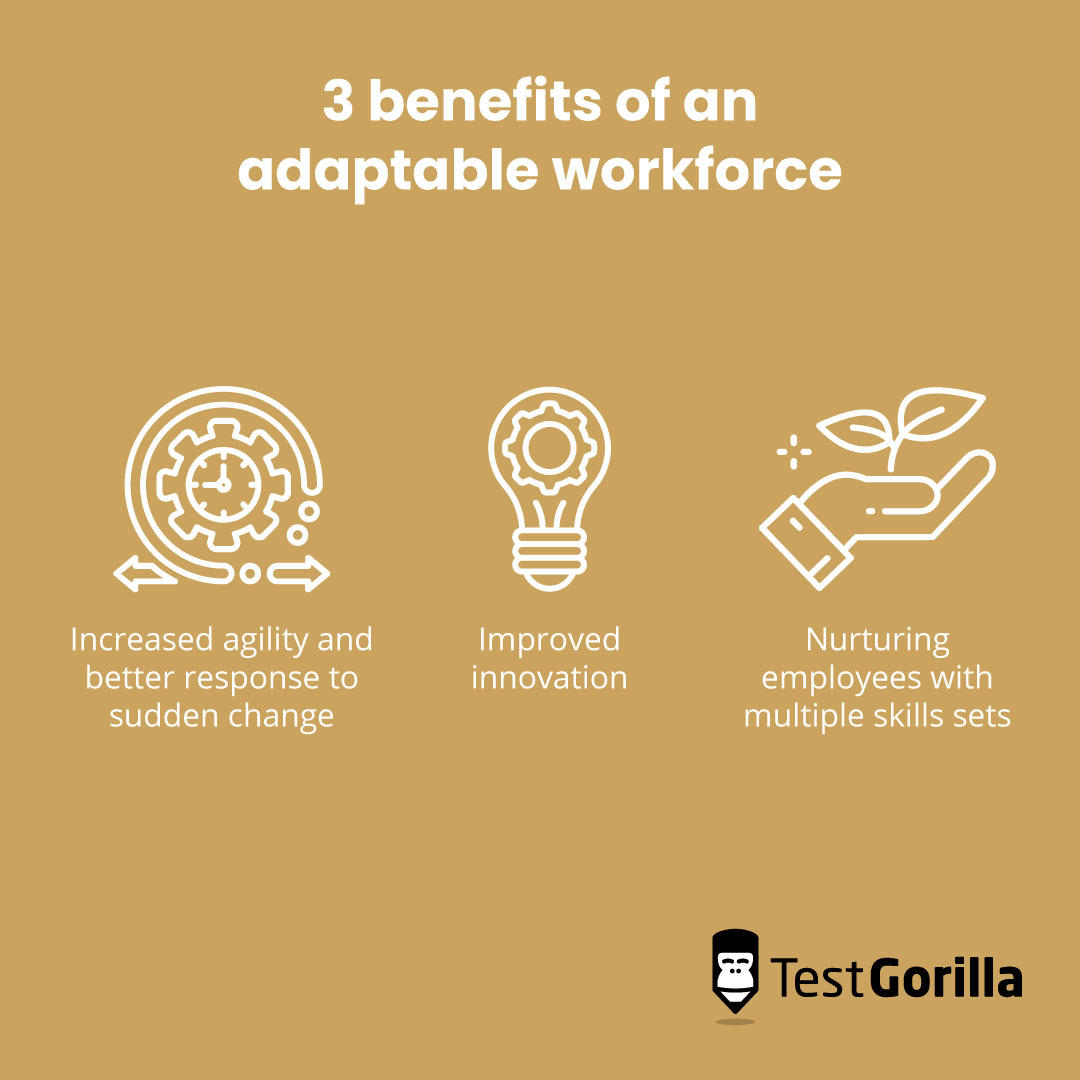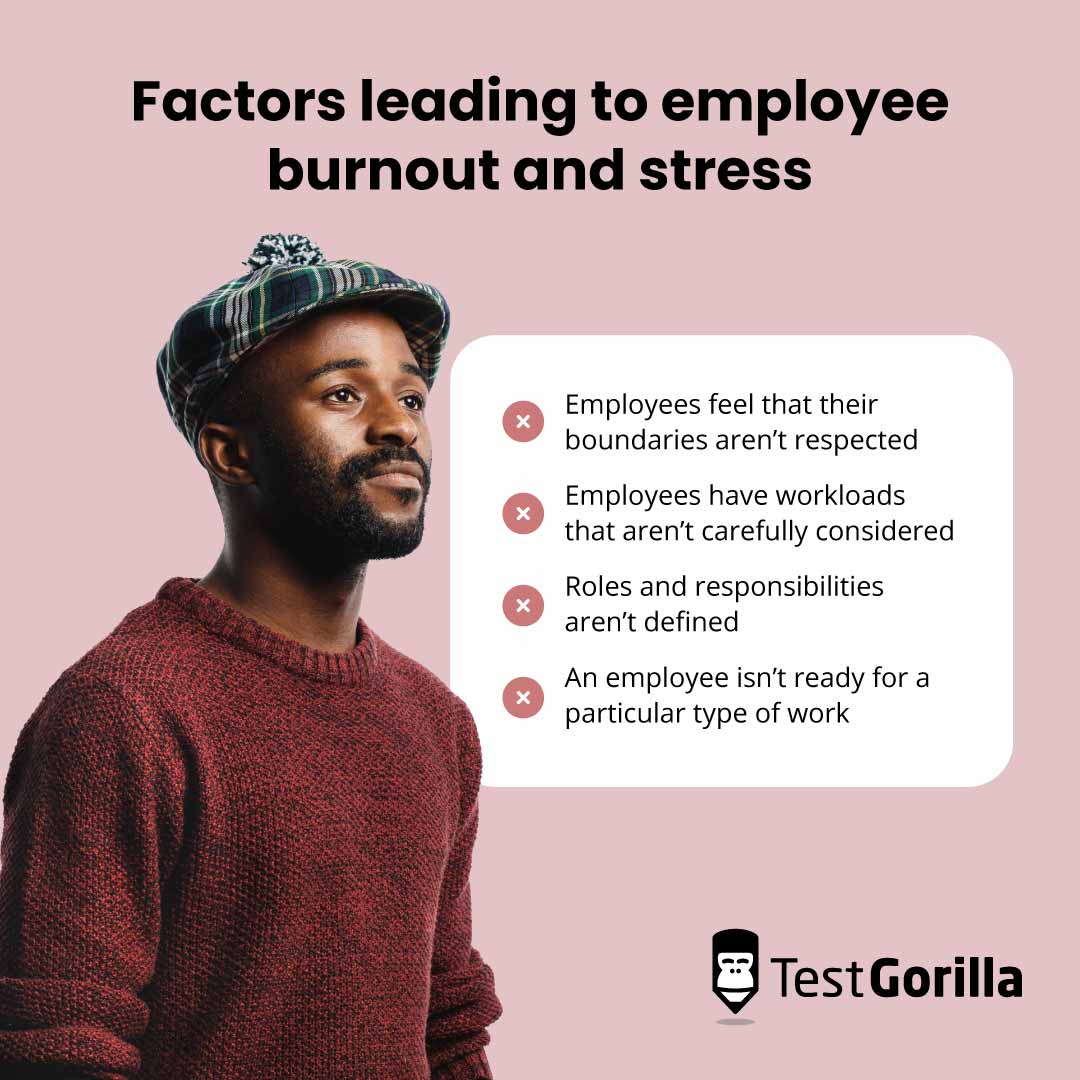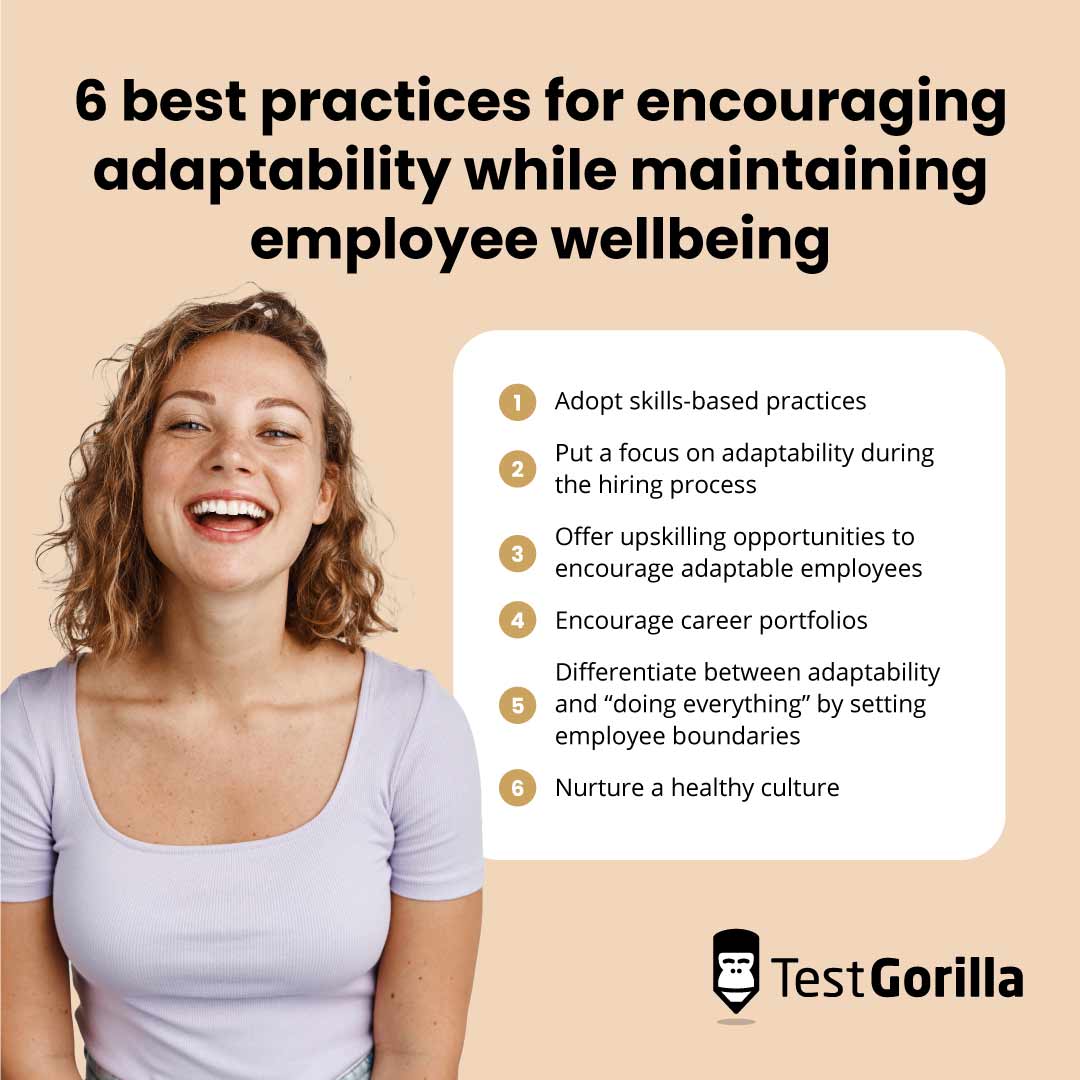Adaptability is not only crucial to our current tumultuous landscape, but it’s also essential in a skills-based environment.
After all, skills-based environments enable workers to use all their capabilities without rigid roles. For example, a marketer with some IT knowledge can help out with IT tasks now and then.
However, many employers are used to asking employees to be adaptable and hearing the line: “That’s not my job.”
This attitude can be frustrating, but employees have their reasons for feeling this way.
Being presented with a task you didn’t sign up for can be maddening in any scenario. This kind of role ambiguity has been shown to be harmful to employee wellbeing, causing burnout and quiet quitting – so you can see where these employees are coming from.
There’s definitely a middle ground to be found, and we’re here to help you find it.
This article discusses the importance of employee adaptability, the possible negative side effects of asking too much from your people, and the balance you can find between the two.
Table of contents
Adaptability is crucial for the future of work
An adaptable workforce is one where employees can perform a variety of tasks and responsibilities and can freely switch to whichever responsibilities are the highest priority.
“Adaptable” and “flexible” are terms used a lot in the modern working world, so let’s quickly differentiate them.“Flexible” refers to a predefined variety of tasks that may change day-to-day. For example, a project manager may have to delegate tasks one day, and the next, they need to make client calls.
“Adaptable,” on the other hand, implies the ability to handle unforeseen changes in tasks, even ones that the person has never encountered before. For example, a project manager must suddenly train a new account manager because of a sudden upskilling need.
Modern organizations need adaptability because it helps them to handle challenges and react to sudden changes.
This is more true now than ever – the working world continues to change and evolve faster and in unpredictable ways.
The benefits of adaptability
Let’s take a look at the benefits of an adaptable workforce:
Increased agility and better response to sudden change
Improved innovation
Nurturing employees with multiple skills sets
Increased agility and better response to sudden change
An adaptable mindset is always helpful, but it’s essential during unprecedented events, such as the Covid-19 pandemic or the Great Reshuffle.
These circumstances caused many organizations to struggle. Suddenly, certain key employees weren’t available due to lockdown and some in-person roles were eliminated entirely. These companies had to find a way to stay strong during immense change.
Some companies were able to use their adaptable workforce during these tough times to keep their work smooth. For example, Unilever used talent sharing to move 9,000 employees from one job to another when certain roles became in high demand during the pandemic.
This is one of the benefits of being a skills-based organization – they’re founded on adaptability. These companies use a focus on skills to stay agile and responsive during times of crisis.
To learn more, read our article on how skills-based hiring increases agility.
Improved innovation
Adaptability means an employee can act on their feet, think of new ideas, and isn’t afraid of change. Curiosity and risk-taking are two of the biggest factors in employee innovation. People need to be open to new challenges and possibilities to innovate and cover new ground.
However, adaptable employees need the right atmosphere to experiment and create. An oppressive culture where mistakes are heavily punished only stifles innovation.
For more information on this topic, read our article on how skills-based hiring impacts innovation.
Nurturing employees with multiple skills sets
When an organization prioritizes adaptability, it also empowers employees with multiple skill sets, and these people are valuable.
An employee that holds varied skill sets (also called a “multipotentialite”) can maintain hybrid roles, but only if that’s encouraged by the company. For example, a content marketer could oversee content production but also hold account management skills to handle external communications with clients.
Discovering employees with varied skill sets helps organizations diversify their work and limit the number of roles necessary for each department – we’ll talk about this more later on.
How adaptability can be detrimental to the health of your employees when done wrong
Adaptability helps companies thrive, but if it isn’t handled with care, expecting too much can damage your employee wellbeingIt’s healthy for an employee to smoothly jump from one task to another, but when a worker is pushed to take on “just one more thing,” it’s no longer adaptability – it’s an overstuffed workload.
Pressuring employees to take on responsibilities they can’t handle can cause employee burnout. This burnout and stress can happen when:
Employees feel that their boundaries aren’t respected
Employees have workloads that aren’t carefully considered
Roles and responsibilities aren’t defined
An employee isn’t ready for a particular type of work
This isn’t just affecting your workers; it’s also affecting your managers. A 2022 study by Future Forum found that 43% of middle managers report burnout alongside 37% of senior managers.
This could be linked to the increasing pressure managers are facing to handle “everything all at once,” or rather, many more responsibilities than they’re used to. The roles of managers and management are changing, but that doesn’t mean it has to be sudden and detrimental.
Pressuring employees to take on more than they can handle eventually wears them down. Their performance suffers, you wonder what went wrong, and the cycle of churn and burn continues.
We know it sounds bad, but there’s a way to encourage an adaptable workforce and prioritize employee wellbeing at the same time.
The 6 best practices for encouraging adaptability while maintaining employee wellbeing
Adaptability is a must-have in the current landscape, but so is a happy workforce. This is our guide to building an adaptable – but healthy – workplace, so you can have the best of both worlds.
Here’s a quick summary of the best practices:
Adopt skills-based practices
Put a focus on adaptability during the hiring process
Offer upskilling opportunities to encourage adaptable employees
Encourage career portfolios
Differentiate between adaptability and “doing everything” by setting employee boundaries
Nurture a healthy culture
1. Adopt a skills-first philosophy
Adopting skills-based hiring is a great approach when you want to achieve adaptability and maintain a satisfied workforce.
Skills-based practices naturally encourage adaptability. These practices focus on skills for all business decisions, such as hiring, upskilling, reskilling, and growth. This means your organization always has an eye on employee skills and which tasks they’re capable of doing.
For example, a skills gap analysis helps you discover which skills your employees have so you can make better decisions about which responsibilities each worker can do.
During a skills gap analysis, you might discover that one of your programmers has above-average communication skills, so you give them the additional task of collecting and communicating updates to other teams. This alleviates a task from a different role – and it’s all because you evaluated and emphasized skills.
What about the wellbeing side of the discussion? Skills-based hiring promotes a healthy workplace through many avenues, including encouraging an inclusive culture and matching employee skill sets to their roles more effectively. For more insights, read our article on skills-based hiring and wellbeing.
2. Put a focus on adaptability during the hiring process
Building an adaptable workforce starts with hiring. This means you need to actively search for candidates with multiple skill sets. For far too long, hiring managers have been put off by candidates with varied career paths, but this is exactly the kind of employee that can bend and shift to an ever-changing schedule.
For example, a recruiter might dismiss a candidate with a history in sales for a human resources coordinator position. But this candidate has the potential to handle sales-related tasks while having extra negotiation skills to facilitate their HR responsibilities.
Multipotentialites possess a broad range of skills and are more accustomed to jumping from task to task. They also typically find it easier.
You can also encourage current employees to develop varied skills by promoting career portfolios at your company, but we’ll speak more about that later.
3. Offer upskilling opportunities to encourage adaptable employees
You can encourage adaptability in your organization by offering employees development opportunities, like upskilling and reskilling. For example, an organization upskills one of their content writers in account management skills so they can help with internal and external communications with clients.
This practice encourages a healthy, adaptable organization, but it also makes your company more attractive to candidates. Learning and development opportunities are in high demand, and offering them can increase your number of job applicants.
Employees in the modern era know that the best way to improve their career path is to jump between employers quickly. A 2021 study by Gallup found that 48% of workers say they would switch jobs if offered upskilling opportunities.
Workers expect professional growth in the same way that companies expect financial growth. When you offer candidates upward mobility, it puts you at the top of their lists.
4. Encourage career portfolios
An adaptable workforce needs a wide range of skills to succeed, and career portfolios encourage a variety of skills and experience. A career portfolio is an employment history that includes a range of professional roles and examples of skill and experience, not just a linear progression through a career ladder.
For example, April Rinne from Harvard Business Review says her career portfolio contains many varied roles, including speaker, author, lawyer, advisor, and more.[1]
This emphasis on variety means that career portfolios naturally bolster flexibility and agility. The more you encourage current employees to develop career portfolios, the more you build an agile workforce for the future. Career portfolios encourage curiosity.
They give employees room to explore and give them an active role in shaping their careers. They also widen your talent pool because you can hire employees that showcase a range of transferable skills.
Like the above-mentioned April Rinne – a candidate who has worked in various roles as a speaker, author, lawyer, and advisor. Her work history demonstrates excellent communication skills, attention to detail, and critical thinking.
To learn more, read our blog post on career portfolios.
5. Differentiate between adaptability and “doing everything” by setting employee boundaries
One of the main reasons that employees burn out is because too many employers believe that “adaptability” equals “overworking.”This can happen when you ask a worker to complete extra tasks without considering their workload.
It can also happen when you don’t inquire about their mental health and personal life. You can mitigate the risk of overwork and burnout by helping your workers establish employee boundaries. Here are a few ways you can help:
Make it company policy to discuss boundaries and agree on these with employees
Nurture a culture of coaching and
Build clear areas of responsibility
Discourage “work outside work”
Make sure your staff are taking their allocated time off
Employee boundaries are crucial to maintaining worker satisfaction and wellbeing, so it’s important to encourage them in your organization. For our full guide, read our blog on setting employee boundaries.
6. Nurture a healthy culture
A positive, inclusive culture is one of the top ways to ensure adaptable, but happy, healthy employees. One of the key elements in a successful work culture is psychological safety.
Nurturing a workplace where employees are free to make mistakes, ask questions, and take risks is essential to building a foundation of trust and safety.This trust and safety promotes employee wellbeing, but it also encourages innovation and agility.
For example, one of the top benefits of workplace diversity is increased innovation, but according to a study by Daan van Knippenberg and Michaéla C. Schippers, diversity doesn’t lead to innovation on its own unless a workplace also fosters psychological safety.[2]
When your employees feel safe and supported, they’re much more likely to tackle challenges head-on because they feel confident confronting new possibilities.
Achieve adaptability and a satisfied workforce with skills-based practices
The modern world demands adaptability to manage ever-changing needs and sudden obstacles – it’s non-negotiable.
But employee wellbeing and satisfaction are just as important, so it’s crucial to focus on balancing the two. Give your employees the resources to learn new skills, adopt a skills-first mindset, and nurture a supportive culture to reap the benefits of a healthy, adaptable workforce.
Adaptability and agility are essential soft skills, like collaboration and critical thinking. These skills are the unsung heroes in your talent pool.
Want to learn more? Read our blog on power skills.
To evaluate a candidate’s agility, try out our 16 personalities test based on Carl Jung's work to measure their adaptability through their processing abilities, decision-making skills, and motivation levels.
Sources
Rinne, April. (October 13, 2021). “Why You Should Build a “Career Portfolio” (Not a “Career Path”).” Harvard Business Review. Retrieved June 15, 2023.
https://hbr.org/2021/10/why-you-should-build-a-career-portfolio-not-a-career-path
van Knippenberg, Daan; Schippers, Michaéla C. (2007). “Work group diversity”. Annu Rev Psychol. Retrieved June 15, 2023. https://pubmed.ncbi.nlm.nih.gov/16903805/
Related posts
Hire the best candidates with TestGorilla
Create pre-employment assessments in minutes to screen candidates, save time, and hire the best talent.
Latest posts
The best advice in pre-employment testing, in your inbox.
No spam. Unsubscribe at any time.

Hire the best. No bias. No stress.
Our screening tests identify the best candidates and make your hiring decisions faster, easier, and bias-free.
Free resources
This checklist covers key features you should look for when choosing a skills testing platform
This resource will help you develop an onboarding checklist for new hires.
How to assess your candidates' attention to detail.
Learn how to get human resources certified through HRCI or SHRM.
Learn how you can improve the level of talent at your company.
Learn how CapitalT reduced hiring bias with online skills assessments.
Learn how to make the resume process more efficient and more effective.
Improve your hiring strategy with these 7 critical recruitment metrics.
Learn how Sukhi decreased time spent reviewing resumes by 83%!
Hire more efficiently with these hacks that 99% of recruiters aren't using.
Make a business case for diversity and inclusion initiatives with this data.






















